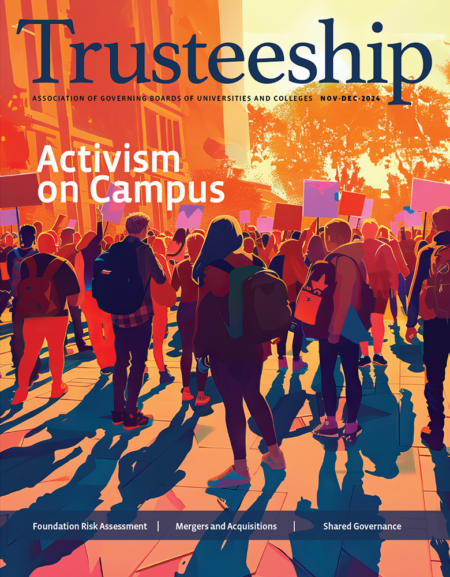
This column is being written in October as the world is confronting multiple painful wars, and the U.S. national election is only 30 days in the offing. The stakes are high, and the tension is palpable across a very divided nation. And as our college and university campuses are well into their respective fall semesters, circumstances remain much as they were when campuses closed for the summer. For those campuses on which Islamic and Jewish protests defined much of last spring’s semester, there remains angst over what happens next. Will campuses erupt again with tent encampments and disruptions to the normal activities of classes, fall sports, and other traditional campus activities? Last spring’s semester also concluded with the departure of several presidents of elite institutions who became political targets in the Congress about antisemitism and campus protests. We witnessed these issues and tensions, most of them falling under higher education’s historic protection of freedom of expression and academic freedom—frequently hyped by the media, politicians, and the public.
So higher education begins anew, as it always has this time of year, albeit with a sense of uncertainty. The concerns about more traditional challenges confronting higher education remain front and center—tuition prices and student success remain issues because they seemingly always are. Institution leaders, including their governing boards, grapple with these concerns as they address overall financial models of changing student demographics, enrollment declines, and other risks to their institution business model. We’ve seen some institutions close programs and layoff faculty and staff. We’ve seen some merge or even close their doors just as we’ve seen legislative bodies assert (or threaten to do so) their authority over funding and taxing institutions with the largest endowments. In the eyes of some, our higher education institutions require more aggressive external direction and control by policy makers to ensure that they achieve their mission and purposes.
As a business predicated on continuous academic improvement and new and creative models of business improvement, aggressive assertions of policy authority can have a limiting effect on a college or university’s drive to take risks and to address the needs of the future—all while the public calls for higher education to do more, to do it for less, and to explore new and adaptable research discoveries. So, while much of the public seems to understand that higher education is an indisputable value-added resource, many elements of that same public appear increasingly comfortable when policy leaders show their teeth and in support of limiting, controlling, and therefore hampering that which our colleges and universities do best.
That’s not to argue that our colleges and universities are infallible; looking forward is filled with risk and even failure. But to intrude on institution missions and initiatives is to pull the rug out from under the core of what our system of higher education—public and private—is about.
Balancing Board Leadership and Independence
The case for higher education’s core values and success should rally those who bear ultimate authority for how these institutions will serve their internal and external stakeholders. It’s the men and women who serve on institution governing boards and who share a similar set of fundamental fiduciary responsibilities. Higher education’s governing boards hold a unique set of responsibilities and expectations—perhaps foremost among them the protection of their board’s independence. The expectation and authorizing principles of independent governing boards of colleges and universities was part of the structure of this nation’s Colonial Colleges, and it was affirmed by the U.S. Supreme Court in the Dartmouth Case in 1819, which recognized the limits of government intrusion into college board governance. The job of fiduciary boards isn’t an easy one; it carries the interests of many stakeholders who are beholden to the decisions and good judgment of the board. Service on the board of a college or university isn’t for the faint of heart; it can be a lonely task shared only with board colleagues.
Today those responsibilities are at risk. Board members of public higher education institutions are increasingly being selected more for their political loyalty than for their background, expertise, and good judgement. The political appointment process, while historically infused with politics, has become exacerbated and is corrupting the essential expectation of board and board member independence from external interference. Clearly, there’s a bit of naivete to expect politically appointed board members to accept an appointment without some commitment to the interests and priorities of those making those appointments. However, recognition of board and board member independence—a necessity for a board to establish policy and make decisions—should be foremost in the minds of appointing authorities and among a board’s own members. Board independence also helps to ensure that higher education isn’t the ping pong of political upheaval. Sadly, we are seeing the opposite in many states and within too many governing boards. The harsh political divide across much of the country is also increasingly playing out in board rooms of private colleges and universities. At the core of independent boards is a commitment to protect and respect an institution’s mission, history, and academic priorities; it is to protect campus academic freedom and free expression of ideas—most especially when those freedoms are seen as divisive. In the end, isn’t that what we should be valuing for our colleges and universities and our students and faculty?
The initiatives among some state governors and legislatures to claim control of what is to be taught (or not taught), and calling for the elimination of specific academic programs, puts government exactly in the place where it has no business being. Debating fact-based teaching of history, revising policies designed to elevate inclusion across an institution’s administration, or making determinations about gender policies on campus are among the important decisions that belong in scope of authority of institution leadership. Boards will ultimately be asked to address such initiatives that might be recommended by institution administrators, some after appropriate input and consultation with faculty. But how and what boards determine to be best policy for the institution they serve should be maintained for the board room—neither developed, mandated, or influenced by external stakeholders. Board members are not foot-soldiers of gubernatorial campaigns or political rhetoric nor do individual board members have authority to act on behalf of their board—fiduciary boards can act only as a corporate body. Serving as a fiduciary is among the highest callings of public service—board members must be willing to stand firm and even be willing to step aside if political expectations compromise their sworn independence.
So, How Best to Proceed in this Moment of Uncertainty?
We are watching governing boards and institution chief executives confront a broad array of challenges and crises. With a new presidential administration in Washington D.C., we can hope that policies will be offered that advance and continue to improve higher education, including a long-awaited reauthorization of the Higher Education Act. Some specific recommendations might be helpful for higher education leadership to consider:
Recommendations for Higher Education Leadership
Board Independence: Some 50,000 men and women serve on the boards of public and private colleges and universities. Regardless of the method of selection or appointment, institutions are defined, in part, by the experience and quality of those who serve as fiduciaries. Board members should be more about good judgement of what is best for the institution than to be expected to be a “representative” of an appointment process or to an individual. The best boards assert and protect their independent authority and make difficult choices for the long-term good of their institution, keeping in mind that their primary fiduciary responsibility is a duty of loyalty to the institution they serve.
Institution President and Governing Board Relations: We are seeing an increasing number of institution presidents who are retiring early from their positions, and we are seeing a decline in quality candidates stepping forward to assume these essential positions. Governing boards need to respect the balance of authority that defines the responsibilities of presidents and those of the governing board. Board members need to resist the inclination to roll their chairs up to the president’s desk and to “help” run the institution during stressful moments or campus crises. It is helpful for boards to recognize that they hired their president based, in part, on how their CEO will lead during the worst days. Boards need to allow their president to lead.
Campus Protests: Campus protests are a part of the learning experience of students. The campus educational experience benefits both from in-class learning as well as learning to live in a culture of differences and debate—including student protests. So long as students and the campus are safe and the education business of the institution can continue, then a campus protest can be among the most important lessons students can receive.
Inclusion Policies: The broad effort of many colleges and universities over the past couple of years to establish DEI departments and initiatives have often met with political pushback. And yet campus inclusion remains an important opportunity for progress. While some states have directed institutions to terminate their DEI offices, boards would be wise to rally to the importance of the initiative and to work with institution leadership to advance this societal value.
American higher education is recognized as the best in the world. We’ve been at this for nearly 400 years, and it will take continued effort to continue to improve the sector and to make it available for all who choose to attend. Governing boards, with a healthy respect and commitment to protecting their independence, will play an enduring role in the sector’s continued improvement. Getting governance right is job #1 for all boards and board members.
Richard D. Legon is the former president and chief executive officer of the Association of Governing Boards of Universities and Colleges (AGB).





